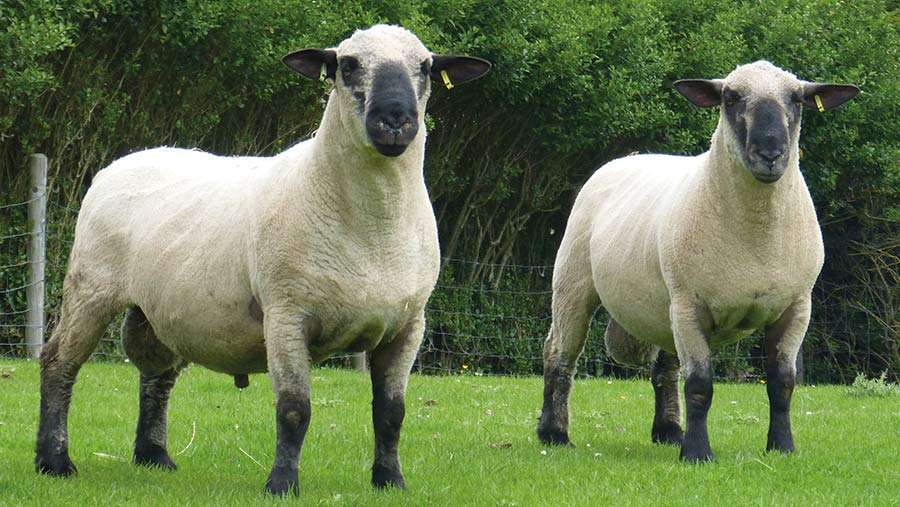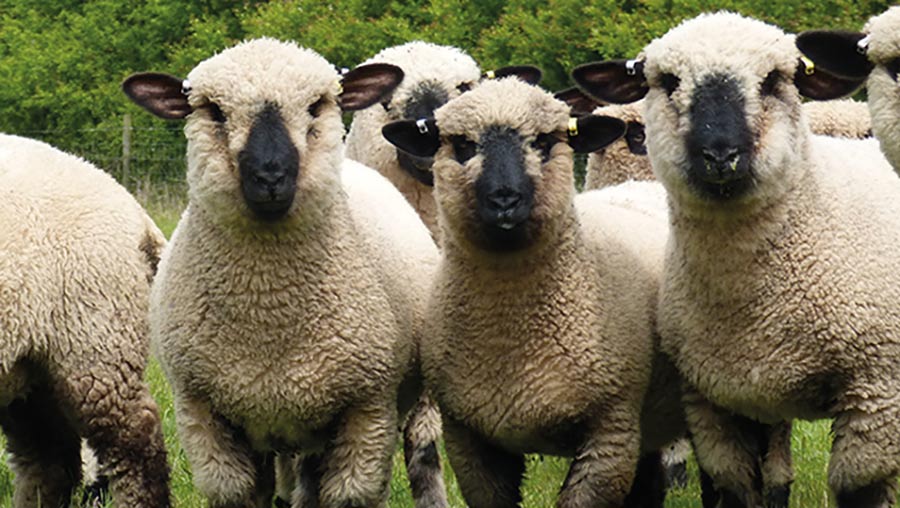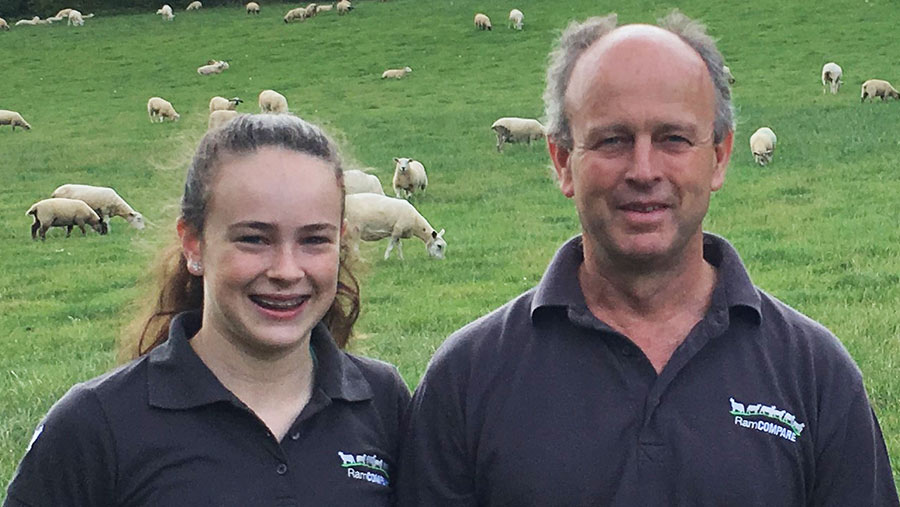Hampshire Down sire saves month on finishing
 Two stock rams at Thorbeck in Linclnshire © MAG/Michael Priestley
Two stock rams at Thorbeck in Linclnshire © MAG/Michael Priestley A Lincolnshire terminal sire flock has used the national RamCompare project to prove that size isn’t everything, and that management and breeding ethos matter most.
A ram from the Thorbeck flock – comprising just 50 sheep at North Thoresby, near Grimsby – was the leading sire for days to slaughter when used on a large commercial flock last year.
Lambs sired by Thorbeck 80X1700402, bred by husband-and-wife team Jim and Jane Birkwood, were market-ready up to 29 days faster for Ian Robertson at Chawton Park in Hampshire (see “Commercial insight: Tup gets lambs away faster off grass”).
See also: How outcrossing achieved table-topping growth rates
Thorbeck Farm facts
- 35 pedigree Signet-recorded Hampshire Downs
- 16 Signet-recorded Texels
- 20ha (50 acres) of permanent pasture
- All-natural service synchronised with sponges
- Prime lambs sold at Louth market
- 15-20 boxed lambs and 20-30 lambs sold to two local restaurants annually
Flock achievements
This has assured the Birkwoods that their genetics perform when up against some of the best in the industry.
RamCompare success for Thorbeck adds to the Signet 10-year genetic progress award and the national champion rosette – for Thorbeck Hurricane – presented in 2017.
Average flock weaning weights have increased 2kg since 2010 at Thorbeck. Last year, single lambs averaged 28.5kg and twins 24.5kg at 56 days.
Flock history
All this has been achieved in just 20 years of performance-recording Hampshire Downs.

The last tail enders are finished with help from creep feed in May and June © MAG/Michael Priestley
After working as an electrical contractor for many years, Mr Birkwood invested in land and started farming 50 commercial Suffolk cross Mules. These were mated to Suffolk rams in 1996.
“It started out as a hobby, then it became a source of income, and since then it’s become an obsession,” he says.
They tried a Kelsey tup, which spurred them on to buy more Hampshires after seeing the vigour and how fast the lambs finish off grass.
Their flock was built using genetics from Mike Adams’ Court flock, Robert Vincent’s Whitehead flock and Henry Derryman’s Yarcombe flock.

Sheep breeders Jim and Jane Birkwood © MAG/Michael Priestley
System and goals
The Birkwoods aim to breed sheep that milk well, have plenty of colostrum, lamb without assistance and wean two 30kg lambs that thrive and finish on permanent pasture.
They test each dam’s colostrum with a Brix refractometer and then assess milk production twice at weekly intervals.
“We’ve found that once they are four or five crop, milk drops off,” says Mr Birkwood. “We have found families of sheep that milk longer, and we have kept them. We were at 50 ewes, but run a younger flock now.”
The family has attended grassland management courses, and while the approach to grazing isn’t hugely technical, they try to move sheep every three days and allow grass to reach the three-leaf stage as much as possible.
Hay for winter feed is made from clover-rich swards. Clover seeds are introduced to fields by putting a handful in lick buckets, which the sheep eat and spread around the fields themselves in dung.
Twin-bearing ewes are supplemented with up to 0.5kg a head a day of an 18% crude protein nut, four to six weeks before lambing.
Ewes and lambs are penned at birth for 12 hours or so and are then turned out to graze on paddocks that have been given three months’ rest over the winter.
“We used to lamb early in December, but are thinking of moving it back to January because spring is less reliable for grass growth,” explains Mrs Birkwood.
Some years, milking ewes need to be kept inside until late March, with lambs offered 0.25kg a head a day of concentrate, but never ad-lib. This year, the cold spring meant ewes were housed a little longer.
This April, lambs were finished on grass and sent to Louth market at 44-46kg, making £140-£150 a head. Tail enders are creep-fed in June.
Maternal trait data is provided through the Signet data, so lambing ease can be monitored, allowing difficult lambers to be culled.
Commercial insight: Tup gets lambs away faster off grass
An extensive outdoor lambing system found Thorbeck 80X1700402 progeny finished the earliest off grass in the summer and quickly off creep in the autumn.
After initially using Charollais and Suffolks, Ian Robertson of Chawton Park, near Alton, Hampshire, has started using Hampshire Downs through RamCompare.
Over the past five years, he has tested 30 different sires from a range of performance-recorded breeds on his Lleyn ewes through RamCompare. He stresses that every ram and breed has good points.
“You can see the estimated breeding values [EBVs] make a difference,” says Mr Robertson. “It’s more obvious when you look at your flock data – you don’t necessarily notice out in the field, although I noticed many of the Hampshire Down lambs were drawn in the earlier slaughter batches.”
The farm’s leading carcass merit tup, a Strathbogie Texel, achieved the top carcass value, which was worth £7.86 a lamb more than average, but took longer to finish.

Ian Robertson and his daughter, Isabella, saw Thorbeck-sired lambs finish quicker at Chawton Park © AHDB
Chawton Park facts
- 1,100 Lleyn ewes, building back up to 1,400
- 270ha (667 acres) of grassland, of which 110ha (270 acres) owned
- Glamping site
- 70 red deer hinds supplying Dovecote Park
- Two full-time labour units plus family labour
- Supplies prime lambs to Randall Parker
System
Lambs are sold deadweight and – weather depending – as stores at Ashford market.
Rams are typically used at a ratio of 80:1. Thorbeck 80X1700402 was used on a range of mixed-age ewes from shearlings to five-crop sheep.
Ewes are not fed any hard feed or given any mineral buckets. The flock lambs from 23 April for two cycles. Triplets are reared as pet lambs. The farm looks to scan at 170% and rear 1.5-1.6 lambs a ewe with terminal sires.
The Thorbeck ram’s progeny were lambed unassisted, which is a prerequisite for the system.
Control
With average rainfall at just 750mm/year, the aim is to get lambs finished off grass and milk as soon as possible so ewe condition can be maintained if a dry spell comes in the summer.
This minimises expensive creep-feeding from late September onwards and ensures ample grazing for tupping.
“I like being more in control of what a ram can do,” says Mr Robertson. “If I know a ram has good EBVs for days to slaughter, this also counts later in the season when they spend less time on lamb creep to finish.
“While some rams produced more valuable, better-conformation carcasses, they often take longer to finish. An extra four weeks’ finishing time, eating 1kg of cake a day and paying £250 or more for lamb pellet, costs £7 a head.”
Lambs by Thorbeck 80X1700402 finished at an average of 208 days, compared with five other rams that had progeny that took 232-248 days.
“This will count more in the future as sheep farming comes under scrutiny for carbon and methane emissions. If we can show days to slaughter falling, we can show the influencers that change is coming.”
Fat depth
Senior Signet breeding manager Samuel Boon, who works on the RamCompare data, says the Thorbeck ram proved a high scan weight was an important trait for getting lambs finished quickly.
Mr Boon adds: “Among the Hampshire Downs on test he had a relatively low fat depth EBV. He produced the third-leanest carcasses of the 38 Hampshire Downs on test.
“This observation also serves to remind folk that speed to finish isn’t all about getting sires with positive fat depth EBVs. To get lambs to finish quickly, rams with high scan weight EBVs are very important.”
